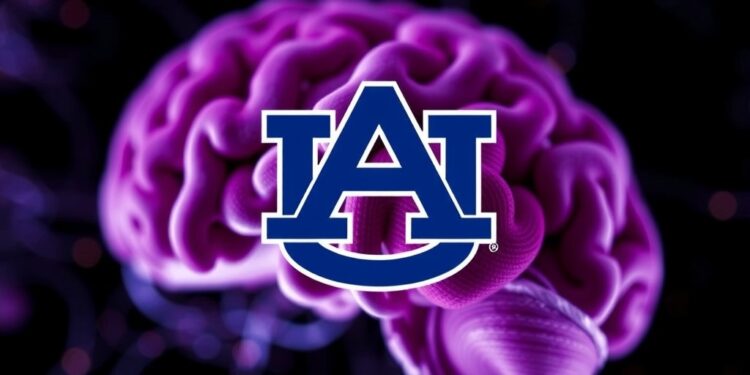In an age where neurodegenerative diseases like Alzheimer’s are becoming increasingly prevalent, new research from Auburn University promises to illuminate the mechanisms underlying neuronal connectivity within the brain. Conducted by a dedicated team of scientists led by Dr. Michael W. Gramlich, this innovative study has utilized the laws of physics to unravel how brain cells, or neurons, maintain their interconnections even when inactive, a process that is typically impaired in Alzheimer’s patients.
Neurons are the fundamental building blocks of the brain, responsible for transmitting information through electrical and chemical signals. For decades, researchers have grappled with the question of how these cells sustain connections during periods of inactivity, often likened to a city maintaining its traffic flow even when the lights are not actively changing. Dr. Gramlich and his team have managed to provide a clear explanation for this phenomenon, revealing that neurons employ a natural force related to entropy—essentially using it as a kind of “invisible glue” to uphold their synaptic connections.
The implications of this research extend far beyond mere academic curiosity. Dr. Gramlich articulated the significance of their findings, suggesting that the failure of this natural force to act correctly could be an early indicator of Alzheimer’s Disease. Understanding this connection is pivotal; it means that interventions can potentially be designed to restore these neuronal connections before the onset of more severe symptoms characteristic of Alzheimer’s.
The innovative methodology employed by the research team involved advanced microscopy and computer modeling to study vesicles, which are small membrane-bound sacs within neurons that play a critical role in neurotransmission. By investigating the density of these vesicles, the team discovered an intriguing correlation: a higher density of vesicles correlates with stronger synaptic connections. This is essential knowledge, as it lays the foundation for targeting vesicle density as a therapeutic strategy in the future.
The study’s findings assert that in Alzheimer’s affected brains, there is a marked alteration in vesicle density, leading to disrupted communication among neurons. This disruption in synaptic communication is likely what precipitates the memory loss and cognitive decline that are hallmarks of Alzheimer’s. By weaving together principles of biology and physics, Dr. Gramlich’s team has opened up a promising new avenue for research into potential treatments for not just Alzheimer’s, but also other neurodegenerative diseases.
While prior research initiatives have predominantly centered on the biological underpinnings of Alzheimer’s, this study’s unique approach demonstrates that harnessing the fundamental principles of physics could yield critical insights into brain function. This interdisciplinary synergy not only enriches our understanding but also propels us toward innovative therapeutic interventions that may one day be capable of mitigating the effects of this debilitating disease.
Another intriguing aspect of this research is its collaborative spirit. The efforts stemmed from a multi-faceted team at Auburn University, including contributions from Dr. Miranda Reed and graduate student Paxton Wilson, alongside a group of dedicated undergraduate students. Their collective commitment underscores the importance of teamwork in scientific discovery, illustrating how diverse talents can converge to achieve a common goal with significant potential impact.
Beyond the immediate research implications, the data gathered from this study could transcend Alzheimer’s research, prompting new strategies to protect neural health as we age. By delineating the mechanisms through which neurons maintain their connections, researchers are presented with novel targets for therapeutic development.
The study’s outcomes resonate with the broader medical community, as they could potentially alter the trajectory of how we manage neurodegenerative diseases. Innovations inspired by this research may lead to the development of preventative measures aimed at preserving cognitive function, perhaps even before the signs of dementia become apparent.
As we look toward the future, it is essential to remain optimistic about the potential for breakthroughs in understanding and treating Alzheimer’s disease. Dr. Gramlich’s discovery invites a paradigm shift in our approach to brain health, asserting that the overlap of disciplines—specifically the fusion of physics and biology—can yield transformative insights into the workings of the human brain.
Ultimately, the findings from Auburn University compel us to rethink our strategies in tackling Alzheimer’s disease. In a field where many approaches have yielded limited results, this innovative lens may provide the clarity needed to forge ahead and develop effective interventions. By focusing on the fundamental processes governing neuronal connections, we are not just uncovering the roots of a devastating disease; we are piecing together the complex puzzle of human cognition itself.
As research continues to evolve, the collaboration fostered within the scientific community will be paramount. Ongoing efforts to investigate the physical principles underlying neuronal behavior may lead to meaningful advancements in both our understanding and treatment of neurodegenerative diseases. The journey toward fighting Alzheimer’s is far from over, but the path illuminated by Dr. Gramlich’s research offers hope for the millions affected by this condition.
With its implications stretching across future treatment avenues and a deeper comprehension of brain health, this breakthrough in neuroscience signifies a crucial step toward safeguarding cognitive function in aging populations. Depth in both physical and biological sciences may hold the key to unlocking new possibilities in the battle against neurodegeneration.
Research like this highlights the importance of interdisciplinary collaboration in addressing complex health challenges. It demonstrates that by leveraging diverse spheres of knowledge, we can develop comprehensive strategies to protect and enhance brain function—paving the way toward innovative solutions, restored connections, and improved quality of life for countless individuals.
As we await further developments stemming from this groundbreaking study, one thing remains clear: understanding and maintaining neuronal connectivity is not just an academic pursuit; it is a critical endeavor that could reshape the lives of millions going forward.
Subject of Research: Cells
Article Title: Presynaptic recycling pool density regulates spontaneous synaptic vesicle exocytosis rate and is upregulated in the presence of beta-amyloid
News Publication Date: 26-Mar-2025
Web References: https://dx.doi.org/10.1016/j.celrep.2025.115410
References: Not provided
Image Credits: Not provided
Keywords
Alzheimer’s disease, neurons, synaptic connections, vesicle density, cognitive decline, neurodegenerative diseases, Auburn University, entropy, brain health, interdisciplinary research.




